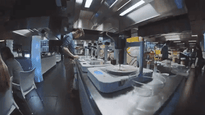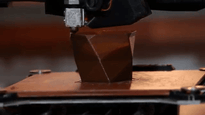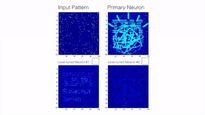In this week's Abundance Insider: Blood-powered fuel cells, the world’s first artificial neuron, and a life-saving diagnosis from IBM Watson.
Cheers,
Peter, Marissa, Cody, Kelley and Greg
P.S. Send any tips to our team by clicking here, and send your friends and family to this link to subscribe to Abundance Insider.
At This Restaurant, the Chef is a 3D Printer

What it is: Food Ink is a London concept restaurant that 3D prints nearly everything, from plateware and tableware to furniture and even food. A critical component of the restaurant's kitchen is byFlow, a device that extrudes pureed ingredients into three-dimensional molds, guided by a robotic arm. The founders say Food Ink is a "platform for a public conversation about how these emerging technologies are rapidly challenging and changing the way we eat, create, share and live."
Why it's important: Peter has previously written about how, in the near future, 3D printers will print personalized food and supplements. Food Ink transforms the fine dining experience by introducing 3D printing and robotics into its kitchen equipment and tweaking some of its food production processes. How else might you use exponential technologies to reinvent traditional social experiences? | Join the Discussion
Spotted by Marissa Brassfield
Blood-Powered Fuel Cell
What it is: Sergey Shleev and his research team at Sweden's Malmo University have created a tiny fuel cell that uses the human body's blood flow to generate its power, and they recently conducted a successful human test with the device. While this idea isn't new -- biocompatible fuel cells have been in development since the 60s -- these power sources have never been successfully demonstrated on humans. Their next task is engineering a charge-storing design to increase the power output.
Why it's important: Imagine pacemakers and other biomedical devices that don't need batteries or a wireless power supply system, even after long-term use. | Join the Discussion
Spotted by Ian Pitchford
Have Your Coffee and 3D Print It Too

What it is: 3DomFuel is a North Dakota startup that transforms agricultural waste -- items like hemp, beer and coffee -- into filaments for 3D printers. The filaments work on any 3D printer that can print with PLA, using the standard PLA settings.
Why it's important: By recycling agricultural waste into ready-to-use filaments, 3DomFuel cuts down on the plastic waste seen elsewhere in the 3D printing industry. These filaments also demonstrate the ever-growing array of materials we can use for 3D printing projects. | Join the Discussion
Spotted by Clyde R. Dennis
World's First Artificial Neuron

What it is: Researchers at IBM's Zurich research lab have created the world's first working artificial neuron. It uses a phase-change material called germanium antimony telluride, which is often found in optical disks, placed between two electrodes. "In the published demonstration, the team applied a series of electrical pulses to the artificial neurons, which resulted in the progressive crystallization of the phase-change material, ultimately causing the neuron to fire," said IBM in a statement. "In neuroscience, this function is known as the integrate-and-fire property of biological neurons. This is the foundation for event-based computation and, in principle, is similar to how our brain triggers a response when we touch something hot. "
Why it's important: With this development, we're one step closer to true neomorphic technology -- effectively, microprocessors and computer components inspired by the human brain. | Join the Discussion
Spotted by Peter Diamandis
MIT and DARPA Pack LIDAR Sensor Onto Single Chip
What it is: The Photonic Microsystems Group at MIT has created a LIDAR-on-a-chip system that could revolutionize how we produce robots, self-driving cars, drones and ocean mapping UAVs. This miniature LIDAR system is so small that it fits on a dime, and has no moving parts. Best of all, it's mass-producible: at volumes of "millions of units per year," the researchers report that the 300-millimeter wafers would cost about $10 each to produce.
Why it's important: This LIDAR-on-a-chip system is remarkable when you consider that today's commercial LIDAR systems cost between $1,000 and $70,000. As this technology continues to demonetize, expect to see it everywhere, from obstacle-avoiding robots to high-speed drones. | Join the Discussion
Spotted by David Rabanus
Miniature Portable Device Produces Pharmaceuticals On Demand at Point of Care
What it is: MIT researchers have created a portable system that can manufacture biopharmaceuticals in real time, nearly anywhere. It's based on Pichia pastoris, a programmable yeast strain that, as KurzweilAI reports, "can be induced to express (generate) one of two therapeutic proteins when exposed to a particular chemical trigger." The researchers say that their experiments thus far have yielded "selectable and near-single-dose production of these biologics in under 24 hours with limited infrastructure requirements."
Why it's important: Tim Lu, who heads up the Synthetic Biology Group at MIT's Research Laboratory of Electronics, explains to KurzweilAI that the system could be used to manufacture vaccines in remote villages, produce treatments for wounded soldiers at the point of care, or facilitate health care in even the most challenging environments. "Imagine you were on Mars or in a remote desert, without access to a full formulary; you could program the yeast to produce drugs on demand locally," he said. | Join the Discussion
Spotted by Marissa Brassfield
Watson Correctly Diagnoses Woman After Doctors Were Stumped
What it is: IBM's cognitive computer Watson recently helped a team of Japanese doctors diagnose a rare form of leukemia. Originally, the doctors diagnosed the female patient with acute myeloid leukemia and initiated a typical course of treatment, but this treatment ultimately proved ineffective. Stumped, they turned to Watson, which compared the patient's genetic data with its database of 20 million oncological studies. In just 10 minutes, Watson identified the correct diagnosis, which enabled doctors to tweak the patient's treatment plan, saving her life.
Why it's important: Artificial intelligence can make complex, data-backed recommendations far faster, easier and more accurately than humans. While the U.S. has already begun to use Artificial Intelligence to support treatment of brain tumors and leukemia, this is the first time Japan has done so. Soon, it will feel unusual to diagnose a condition like cancer without first conducting a genetic analysis using Artificial Intelligence. | Join the Discussion
Spotted by Cody Rapp
A Health-Monitoring Sticker Powered by Your Cellphone
What it is: John Rogers, an epidermal electronics specialist, researcher and entrepreneur, has recently unveiled a flexible, stretchy skin patch that can monitor the wearer's sun exposure and heart rate. Unlike other smart patches we've seen, Rogers' contains an NFC chip that draws power from the radio signals of nearby cell phones or tablets.
Why it's important: Wearables and sensors that don't need batteries can be much thinner than devices with built-in batteries. This health-monitoring patch leverages a cultural phenomenon -- gadgets all around us, always -- to streamline its design. | Join the Discussion
Spotted by Marissa Brassfield
Tesla Car Drives Owner to Hospital After He Suffers Pulmonary Embolism
What it is: Joshua Neally recently had a life-changing experience thanks to semi-autonomous car technology. During his commute to work one day in late July, Neally pulled onto the highway and began feeling piercing chest and stomach pains. Using his Tesla Model X's Autopilot mode, Neally directed the car straight to the emergency room, where he was treated for a pulmonary embolism.
Why it's important: We forget just how easy it is for safe drivers to drive dangerously. As Peter has previously discussed, autonomous cars can transport human drivers to their destination faster and safer than traditional cars -- all while saving millions of lives every year. | Join the Discussion
Spotted by Cody Rapp
Also read: TOP 50 MOON SHOTS
WHAT IS ABUNDANCE INSIDER?
This email is a briefing of the week's most compelling, abundance-enabling tech developments, curated by Marissa Brassfield in preparation for Abundance 360. Read more about A360 below.
WANT MORE CONVERSATIONS LIKE THIS? - JOIN ME
At Abundance 360, Peter's 360-person executive mastermind, we teach the metatrends, implications and unfair advantages for entrepreneurs enabled by breakthroughs like those featured above. We're looking for CEOs and entrepreneurs who want to change the world. The program is highly selective. Apply now for Abundance360 Summit if you'd like to develop an Abundance mindset.
Know someone who would benefit from getting Abundance Insider? Send them to this link to sign up.
P.S. I've just released a podcast with my dear friend Dan Sullivan called Exponential Wisdom. Our conversations focus on the exponential technologies creating abundance, the human-technology collaboration, and entrepreneurship. Head here to listen and subscribe.